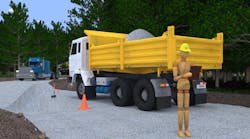Backup alarms alert workers when a machine or truck reverses, allowing them to move to safety. A video from the IRSST, an occupational safety research institute based in Quebec, explains how the positioning and type of alarm affects job-site safety.
The group identifies two types of alarms, tonal and broadband, recommending the use of broadband in situations where multiple vehicles may be backing up.
Broadband alarms are more effective than tonal alarms, according to IRSST researcher Hugh Nelisse, especially when workers have to identify the sound source.
IRSST said three factors play into backup alarms performing as they should: positioning on the vehicle, the volume level, and the reversing speed of the vehicle.
- Alarms should be mounted on the rear of the vehicle, 1 to 2 meters above the ground, pointed toward the hazard zone, and easily visible by a worker in the area.
- The volume should be set slightly above the level of ambient noise in order to warn workers who have no hearing loss or are not wearing hearing protection.
- Vehicles should not reverse at speeds greater than 12 kilometers per hour (7 mph), which allows workers at least two seconds to react and move out of the way.
Source: IRSST





